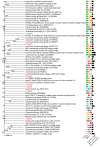Identification of Huge Phages from Wastewater Metagenomes
- PMID: 38140571
- PMCID: PMC10747093
- DOI: 10.3390/v15122330
Identification of Huge Phages from Wastewater Metagenomes
Abstract
Huge phages have genomes larger than 200 kilobases, which are particularly interesting for their genetic inventory and evolution. We screened 165 wastewater metagenomes for the presence of viral sequences. After identifying over 600 potential huge phage genomes, we reduced the dataset using manual curation by excluding viral contigs that did not contain viral protein-coding genes or consisted of concatemers of several small phage genomes. This dataset showed seven fully annotated huge phage genomes. The phages grouped into distinct phylogenetic clades, likely forming new genera and families. A phylogenomic analysis between our huge phages and phages with smaller genomes, i.e., less than 200 kb, supported the hypothesis that huge phages have undergone convergent evolution. The genomes contained typical phage protein-coding genes, sequential gene cassettes for metabolic pathways, and complete inventories of tRNA genes covering all standard and rare amino acids. Our study showed a pipeline for huge phage analyses that may lead to new enzymes for therapeutic or biotechnological applications.
Keywords: huge phage; metagenome; viral metagenomics; virus genome annotation; virus phylogeny; wastewater.
Conflict of interest statement
The authors declare no conflict of interest.
Figures


References
MeSH terms
Substances
Grants and funding
LinkOut - more resources
Full Text Sources

